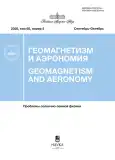A simple formula for the total electron content in the nequick model: 1. VTEC
- 作者: Deminov M.G.1
-
隶属关系:
- Pushkov Institute of Terrestrial Magnetism, Ionosphere and Radio Wave Propagation of the RAS (IZMIRAN)
- 期: 卷 65, 编号 5 (2025)
- 页面: 669-676
- 栏目: Articles
- URL: https://journal-vniispk.ru/0016-7940/article/view/352725
- DOI: https://doi.org/10.7868/S3034502225050104
- ID: 352725
如何引用文章
详细
A simple formula is presented for calculating the vertical total electron content, VTEC, from the data on the E-, F1-, and F2-layer maxima within the frames of the NeQuick model. It is found that the error of this formula does not exceed 2% compared to a more exact solution method, i.e., obtaining VTEC within the NeQuick model as an integral of the electron density along a vertical ray from the base of the ionosphere to the height of approximately 20000 km. The magnitude of this error varies with local time, season, and latitude, which indicaes the possibility of further refinement of the presented formula.
作者简介
M. Deminov
Pushkov Institute of Terrestrial Magnetism, Ionosphere and Radio Wave Propagation of the RAS (IZMIRAN)
编辑信件的主要联系方式.
Email: deminov@izmiran.ru
Moscow, Troitsk, Russia
参考
- Afraimovich E.L., Astafyeva E.I., Demyanov V.V. et al. A review of GPS/GLONASS studies of the ionospheric response to natural and anthropogenic processes and phenomena // J. Space Weather Spac. V. 3. ID A27. 2013. https://doi.org/10.1051/swsc/2013049
- Angrisano A., Gaglione S., Gioia C., Massaro M., Robustelli U. Assessment of NeQuick ionospheric model for Galileo single-frequency users // Acta Geophys. V. 61. № 6. P. 1457–1476. 2013. https://doi.org/10.2478/s11600-013-0116-2
- Aragon-Angel A., Zürn M., Rovira-Garcia A. Galileo ionospheric correction algorithm: An optimization study of NeQuick-G // Radio Sci. V. 54. № 11. P. 1156–1169. 2019. https://doi.org/10.1029/2019RS006875
- Bilitza D., Pezzopane M., Truhlik V., Altadill D., Reinisch B.W., Pignalberi A. The International Reference Ionosphere model: A review and description of an ionospheric benchmark // Rev. Geophysics. V. 60. № 4. ID e2022RG000792. 2022. https://doi.org/10.1029/2022RG000792
- Di Giovanni G., Radicella S.M. An analytical model of the electron density profile in the ionosphere // Adv. Space Res. V. 10. № 11. P. 27–30. 1990. https://doi.org/10.1016/0273-1177(90)90301-F
- European Commission. European GNSS (Galileo) open service – ionospheric correction algorithm for Galileo single frequency users. Issue 1.2. 2016. https://www.gsc-europa.eu/sites/default/files/sites/all/files/Galileo_Ionospheric_Model.pdf
- Gulyaeva T., Bilitza D. Towards ISO standard earth ionosphere and plasmasphere model / New Developments in the Standard Model. Ed. Larsen R.J. Ch. 1. London: Nova Science Publishers Inc. P. 1–39. 2012. ISBN 978-1-61209-989-7
- Hoque M.M., Jakowski N., Prol F.S. A new climatological electron density model for supporting space weather services // J. Space Weather Spac. V. 12. ID 1. 2022. https://doi.org/10.1051/swsc/2021044
- Hofmann-Wellenhof B., Lichtenegger H., Wasle E. GNSS–global navigation satellite systems: GPS, GLONASS, Galileo, and more. Wien: Springer-Verlag, 516 p. 2008. https://doi.org/10.1007/978-3-211-73017-1
- ITU. Ionospheric propagation data and prediction methods required for the design of satellite services and systems. Recommendation P. 531-12, Geneva. 2013.
- Jones W.B., Gallet R.M. The representation of diurnal and geographic variations of ionospheric data by numerical methods // Telecommun. J. V. 29. № 5. P. 129–149. 1962.
- Jones W.B., Gallet R.M. The representation of diurnal and geographic variations of ionospheric data by numerical methods. 2 // Telecommun. J. V. 32. № 1. P. 18–28. 1965.
- Nava B., Coisson P., Radicella S.M. A new version of the NeQuick ionosphere electron density model // J. Atmos. Sol.-Terr. Phy. V. 70. № 15. P. 1856–1862. 2008. https://doi.org/10.1016/j.jastp.2008.01.015
- Pezzopane M., Pignalberi A., Pietrella M., Haralambous H., Prol F., Nava B., Smirnov A., Xiong C. An update of the NeQuick-Corr topside ionosphere modeling based on new datasets // Atmosphere. V. 15. № 4. ID 498. 2024. https://doi.org/10.3390/atmos15040498
- Pignalberi A., Pezzopane M., Themens D.R., Haralambous H., Nava B., Coisson P. On the analytical description of the topside ionosphere by NeQuick: Modeling the scale height through COSMIC/FORMOSAT-3 selected data // IEEE J-STARS. V 13. P. 1867−1878. 2020. https://doi.org/10.1109/JSTARS.2020.2986683
- Radicella S.M., Zhang M.-L. The improved DGR analytical model of electron density height profile and total electron content in the ionosphere // Ann. Geophys. – Italy. V. 38. № 1. P. 35−41. 1995. https://doi.org/10.4401/ag-4130
- Rawer K. Replacement of the present sub-peak plasma density profile by a unique expression // Adv. Space Res. V. 2. № 10. P. 183–190. 1982. https://doi.org/10.1016/0273-1177(82)90387-8
- Themens D.R., Jayachandran P.T., Bilitza D., Erickson P.J., Häggström I., Lyashenko M.V., Reid B., Varney R.H., Pustovalova L. Topside electron density representations for middle and high latitudes: A topside parameterization for E-CHAIM based on the NeQuick // J. Geophys. Res. – Space. V. 123. № 2. P. 1603–1617. 2018. https://doi.org/10.1002/2017JA024817
补充文件









